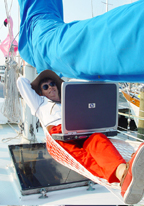 |
||
|
||
September’s Hurricane HideoutSearching for protection, space, holding and depthSeptember often brings hurricanes out in force. We’ve been anchored out during hurricanes the past three years, twice when the storms hit on September 18. Our fall cruise in September will tell whether we make four in a row or not. Because you, too, may be out, it’s time to review another hurricane hideout gunkhole. The Big FourConsider four main factors in choosing a hurricane anchorage around Chesapeake Bay: protection, space, holding quality and water depth. First, most hurricanes that head our way come from the south or southeast. So the best retreat will be to a place with protection from the winds coming from those directions. The higher the shoreline and the more trees there are, the better sheltered you will be. Space is the second factor to consider. You don’t want to be in some small cove where you might be driven aground should your anchor drag. Crowded sanctuaries aren’t really sanctuaries, so you don’t want to be jammed up near other boats that could drag and crash into your boat. A rocky bottom doesn’t make for good anchoring; it just won’t hold well. So wherever you decide to anchor in a storm, know what the bottom is made of. Some cruising guides for the Bay will tell you the holding quality of particular locations. Depth is the other primary consideration. Keep in mind that hurricanes can cause extreme tides. The winds can pull or push the water in and out much faster and in more volume than under general storm conditions. The more depth you have in your gunkhole safe-spot, the better. Gone FishingFor Hurricane Ivan in 2005, we went fishing. Well, not exactly. We went to Fishing Creek to seek refuge from the blustery storm. Feeding into the south side of the Little Choptank River on the Eastern Shore, Fishing Creek provided a near-perfect place to spend some quality storm time. Consult your charts before you leave, and plot a course that will take you well south of Tilghman Island (if coming from the north), toward James Island. This small tree-dotted landmark is the first visible landmark to signal the approach to the Little Choptank. Coming from the south, you will see the island to starboard. In either case, do not go near the island but swing around its northern side, then head just southeast toward lighted Green 3. This takes you into the mouth of the river. Keep the buoy to port, and follow the channel, watching your depth closely, toward Green 2. The river then bends to the northeast. Follow along past the Green 7. The mouth of Hudson Creek will be to port; you will see the Green 9 ahead. Continue on to the northeast toward the Green 11, then look for the Red 2 ahead to starboard, marking the eastern shore of Fishing Creek. Turn to starboard into the mouth of the creek as you approach this buoy. The creek hooks around to the southeast and will lead you into a sizeable sheltered cove with about 13 feet of water. The banks are tree lined, and you are very well protected here. This anchorage has good holding, plenty of space and depth. While it’s a popular gunkhole for general cruising, it’s not likely to be crowded because there’s plenty of room for several boats to gather without endangering one another. No Need to Hurry HomeAnchoring out during a hurricane on the Bay is generally better than being tied to a dock, so think twice before hurrying to port if one is approaching. Why? If you’re anchored securely in plenty of water, away from shore, you won’t be slammed into a dock or the boat next door. If you’ve watched hurricane coverage on television, you’ve seen that boats in port are frequently smashed against pilings or piers or driven aground, sustaining considerable damage or destruction. If you’re tied to a dock, you will be constantly changing your lines as the waters climb and recede, requiring more attention and energy than if you are simply anchored. You just need to make sure your anchoring is secure, and you may want to drop two anchors instead of just one. This is also a good time to put out an anchor sail, if you have one, to reduce the amount of sway in heavy windage. Keeping a Good WatchWhile protection, space, holding and depth are the big four physical considerations for choosing a hurricane hideout, one thing more is critical. Keep a good watch. No matter how securely you think you’ve anchored your vessel, you must remain vigilant. It’s still possible to drag if the gale becomes too violent, and if you’re anchored near other boats, you need to be alert in case one of them drags anchor. Changing conditions also may make it advisable to reposition your boat. Finally, there are those of us who just plain enjoy the thrill of anchoring in a hurricane. A little bit of life on the edge is part of what real boating is all about, isn’t it? |
||
|
|
||
|
© COPYRIGHT 2004 by New Bay Enterprises, Inc. All rights reserved. |

